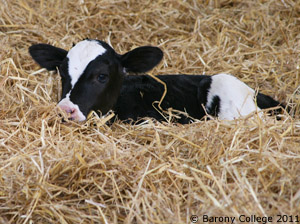Controlling Cryptosporidia in Dairy Calves

Cryptosporidiosis is one of the most common causes of scour in calves, caused by the protozoal organism Cryptosporidium parvum. Antibiotics cannot be used to treat this disease and there are no effective vaccines either, making it very difficult to prevent and eliminate from a herd. Prevention of clinical cases centres around good colostrum management, cleanliness and disinfection procedures and managing the housing environment to reduce the spread of infection.
Colostrum
- Good colostrum management is important to maximise the calf’s immunity and remember the 3 Q’s - quality, quantity and quickly!
- Measure colostrum quality (antibody or immunoglobulin IgG content) with a Brix refractometer or colostrometer. The target is for colostrum to contain over 50g IgG/litre (see table below). Aim to feed all calves 10% of their birth weight (so a 40kg calf should receive four litres of colostrum) as soon as possible after birth and ideally within the first two to three hours.
- Passive transfer of antibodies is best achieved by administering colostrum via a stomach tube as opposed to feed with a bottle and teat or leaving the calf to suckle the dam.
- Any calf that might be acidotic after a bad or prolonged calving, will have poorer absorption of antibodies and treating the calf with bicarbonate can help improve passive transfer.
- Pasteurising colostrum can reduce the bacterial content, helping improve antibody absorption, and reduce the risk of transferring of other disease pathogens to the calf.
- Consider vaccinating dry cows against Rotavirus so that cows produce antibodies to this disease in colostrum. Combined infections are common, and the stress of other infections can trigger more serious cryptosporidia problems.
- Ensure thorough cleaning and disinfection of feeding equipment such as buckets, teats, stomach tubes and whisks. Bacteria can cause rapid gut closure, reducing the absorption of antibodies.
| Colostrometer Reading | Brix Refractometer Reading | Quality | IgG Level | Recommendation |
|---|---|---|---|---|
| Green | >22% | Superior | ≥ 50g/litre IgG | Use as a first feed |
| Amber | 20 - 22% | Medium | 20 - 49g/litre IgG | Only use for second or third feed |
| Red | <20% | Poor | ≤ 20g/litre IgG | Do not use as colostrum |
Nutrition
- Keep calves well fed to maintain energy intake, especially in colder weather as any nutritional or energy stresses on the calf can make the symptoms of infection more severe. Underfed calves will have less energy available to support the immune system.
- Feed healthy calves first and sick ones last as the infection can be easily spread between calves via feeding equipment, dirty overalls or on footwear.
Hygiene
- Thoroughly clean and disinfect all calf pens after use (both individual pens and group pens). For group housing operate a batch system if possible (all in all out).
- Disinfectants work best after steam cleaning to get rid of dirt.
- Only certain disinfectants are licensed for use against cryptosporidia and the parasite is highly resistant to chlorine-based disinfectants. Always follow manufacturers guidance on product usage.
- Have a disinfectant foot dip outside the calf shed for workers and visitors to use before entry and on exit.
- If using calf jackets, they should be washed at a minimum of 60˚C. Only temperatures over 60˚C will kill cryptosporidia eggs.
Housing environment
- Calving pens must be clean and dry and once cows have calved, separate the calf as quickly as possible. Adult cattle can shed millions of cryptosporidia eggs but show no symptoms of infection.
- Individual calving pens should be thoroughly cleaned and disinfected after each calving and regular disinfection of group calving pens is also recommended, although not always easy to implement in practice when cows are regularly added to the group in an all-year-round calving system.
- Keep the calf house as clean and dry as possible with good ventilation but avoid drafts at calf level as this can chill calves. The parasite can survive for more than a year in wet or damp conditions but will die in dry conditions.
- Offer plenty of fresh straw to reduce moisture in bedding. This also allows for good nesting behaviour, helping to keep calves warm.
- Keep stocking rates as low as possible.
Grouping calves
- Keep different age groups apart because older animals can be infected and shed the pathogen without showing clinical signs.
- Never mix new-born calves with calves older than three to four days.
- Ideally have no more than a spread of 14 days of age within a group of calves.
Isolation
- Sick animals should be isolated immediately once clinical signs of disease are evident. They should remain isolated for at least a week until after the scouring has stopped as calves can still shed eggs after they appear to have recovered.
Sign up to the FAS newsletter
Receive updates on news, events and publications from Scotland’s Farm Advisory Service
